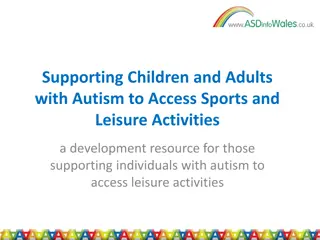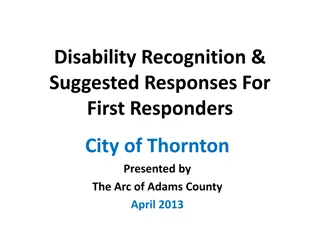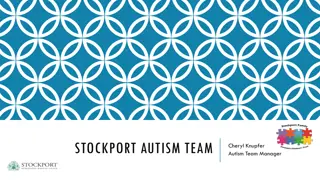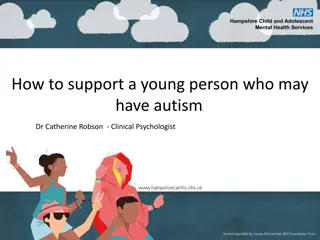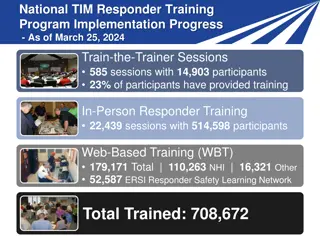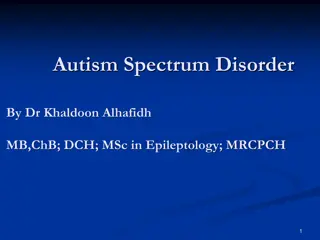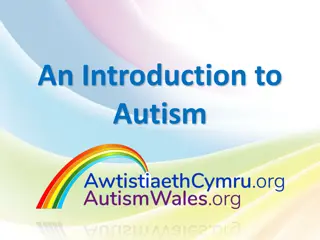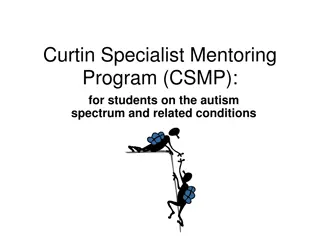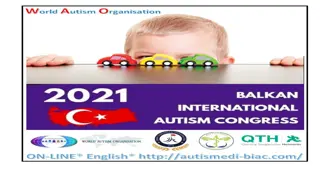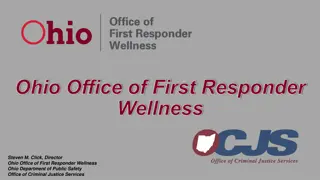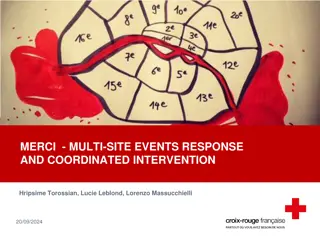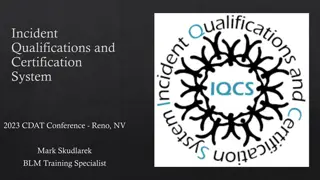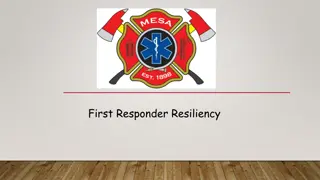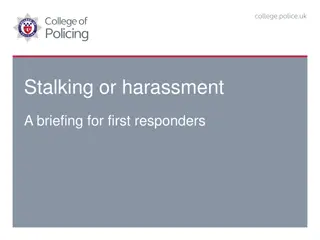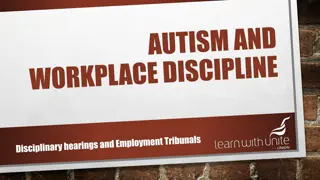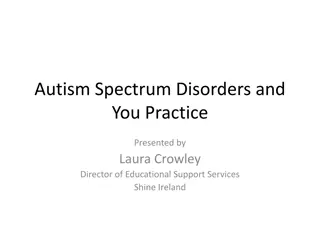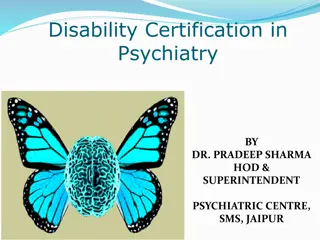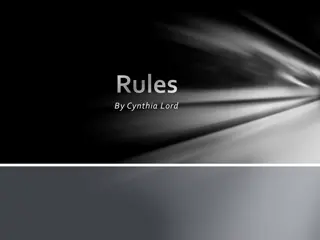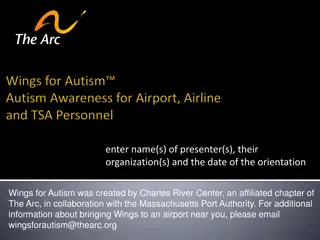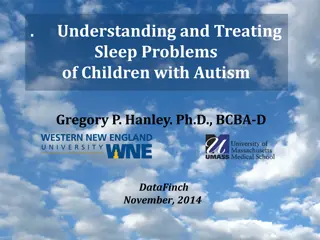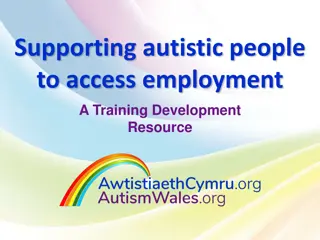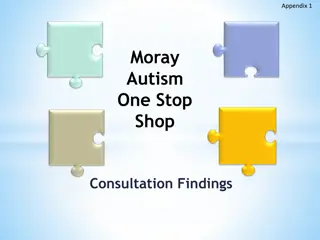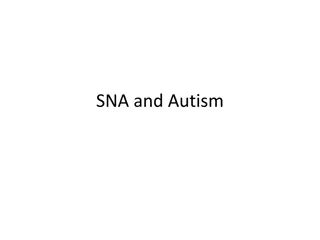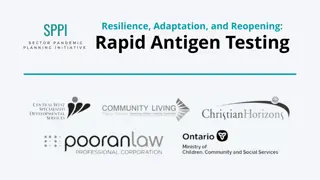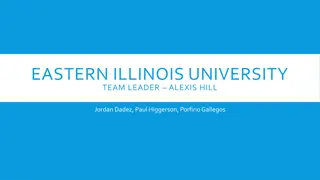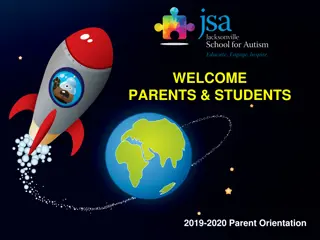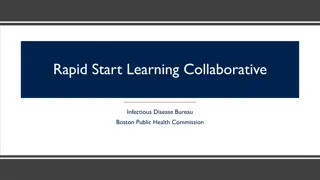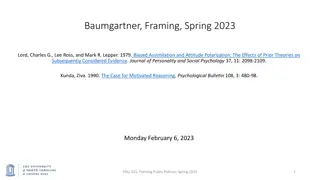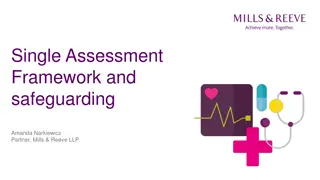Understanding Rapid Responders in Autism: Evidence-Based Practices and Training
Autism spectrum disorder (ASD) presents varying response rates in children, leading to interest in optimal outcomes. Historical perspectives highlight positive and negative outcomes of behavioral interventions, emphasizing the importance of factors like early diagnosis and intervention. Rapid responders show significant gains with timely and tailored treatments. Evidence-based practices and training programs are crucial in supporting individuals with ASD, focusing on social skills, behavior assessment, and parent involvement. Resolving controversies and synthesizing best practices contribute to improving outcomes for individuals with autism.
Download Presentation

Please find below an Image/Link to download the presentation.
The content on the website is provided AS IS for your information and personal use only. It may not be sold, licensed, or shared on other websites without obtaining consent from the author. Download presentation by click this link. If you encounter any issues during the download, it is possible that the publisher has removed the file from their server.
E N D
Presentation Transcript
A SYNTHESIS OF RAPID RESPONDING TYPOLOGY KIERSTEN COLE SUPERHEROES SOCIAL SKILLS TRAINING, RETHINK AUTISM INTERNET INTERVENTION, PARENT TRAINING, EVIDENCE-BASED PRACTICES CLASSROOM TRAINING, FUNCTIONAL BEHAVIOR ASSESSMENT: AN AUTISM SPECTRUM DISORDER, EVIDENCE-BASED PRACTICES TRAINING TRACK FOR SCHOOL PSYCHOLOGISTS US OFFICE OF EDUCATION PERSONNEL PREPARATION PROJECT GRANT H325K12306 WILLIAM JENSON, PH.D., ELAINE CLARK, PH. D., JOHN DAVIS, PH.D., JULIA HOOD, PH.D.
OVERVIEW 1. What is autism? 2. Historical background and identification of rapid responder characteristics Lovaas et al., 1987; McCeachin et al., 1993 Sallows and Graupner 2005 3. Who are the rapid responders? 1. Child factors 1. IQ 2. Communication 3. Severity of Symptoms/Restrictive Repetitive Behaviors 2. External Factors 1. Early Diagnosis 2. Access to early intervention 4. Resolving Controversy with Best Outcome 1. A critical review of Feins et al., 2013 2. A critical review of Anderson et al., 2014 5. Best evidence Synthesis of Rapid Responding Typology 6. Conclusion
2. HISTORICAL BACKGROUND AND IDENTIFICATION OF RAPID RESPONDER CHARACTERISTICS Clinicians have identified differential rates of responding in children with ASD. Empirical results from behavioral intervention with autistic children have been both positive and negative. On the positive side, behavioral treatment can build complex behaviors, such as language, and can help to suppress pathological behaviors, such as aggression and self-stimulatory behavior. Lovaas 1987 Cases in which children have responded well to treatment has led to increased interest in the varying outcomes for children with autism, and in particular optimal outcome.
2. HISTORICAL BACKGROUND AND IDENTIFICATION OF RAPID RESPONDER CHARACTERISTICS Response rates as a function of access to treatment (The Initial Lovaas Perspective) Clients vary widely in the amount of gains obtained but show treatment gains in proportion to the time devoted to treatment. treatment gains have been specific to the particular environment in which the client was treated, substantial relapse has been observed at follow-up, and no client has been reported as recovered.
2. HISTORICAL BACKGROUND AND IDENTIFICATION OF RAPID RESPONDER CHARACTERISTICS Response rates as a function of Child factors (The Sallows & Graupner Perspective) The number of weekly hours of treatment is less related to outcome than pretreatment variables. Treatment outcome is best predicted by pretreatment characteristics.
INTEREST IN OPTIMAL OUTCOMES : DISAGREEMENT IN VOCABULARY Losing Diagnosis of ASD Very Positive Outcome Recovered/Best Outcome Optimal Outcome
DEFINITION OF A RAPID RESPONDER A rapid responder is a child with Autism who: rapidly acquires skills in response to treatment, resulting in gains in mental age at an average rate of 12-18 months per year, greatest gains being made within the first year of treatment, and an average of 1.5-2 SD increase in IQ. (Sallows & Graupner 2005; Lovaas 1987; McEachin et al. 1993)
REVIEW OF RESEARCH FOR CHILDREN WITH ASD IDENTIFYING DIFFERENTIAL RATES OF RESPONDING Lovaas, 1987 McEachin et al., 1993 Sallows & Graupner, 2005
LOVAAS 1987 : BEHAVIORAL TREATMENT AND NORMAL EDUCATIONAL AND INTELLECTUAL FUNCTIONING IN YOUNG AUTISTIC CHILDREN Lovaas sought to maximize behavioral treatment gains by treating autistic children during most of their waking hours for many years He hypothesized that contruction of a special, intense, and comprehensive learning environment for very young children with ASD would allow some of them to catch up with their normal peers by first grade.
LOVAAS1987 : BEHAVIORAL TREATMENT AND NORMAL EDUCATIONAL AND INTELLECTUAL FUNCTIONING IN YOUNG AUTISTIC CHILDREN Procedure Subjects were assigned to one of three groups: Intensive-treatment experimental group (n=19) that received 40 hours of one-to-one treatment per week. Minimal-treatment control group 1 (n=19) that received 10 hours or less of one-to-one treatment per week. Minimal-treatment control group 2 (n=21) that received 10 hours or less of one-to-one treatment per week (Control Group 2 was a type of back up and were treated like Control Group 1, but were not treated by the Young Autism Project). All three groups received treatment for 2 or more years.
LOVAAS1987 : BEHAVIORAL TREATMENT AND NORMAL EDUCATIONAL AND INTELLECTUAL FUNCTIONING IN YOUNG AUTISTIC CHILDREN Results Experimental Group: 9 children (47 percent) passed through: normal first grade in a public school, and obtained an average or above average score on IQ tests (M=107, range= 94-120). 8 children (42 percent) passed first grade in aphasia classes and achieve IQ scores within mildly retarded range of intellectual functioning (M=70, range=56-95). 2 children (10 percent) were placed in classes for autistic/retarded children and scored in the profoundly retarded range (IQ<30).
LOVAAS1987 : BEHAVIORAL TREATMENT AND NORMAL EDUCATIONAL AND INTELLECTUAL FUNCTIONING IN YOUNG AUTISTIC CHILDREN Results Control Groups 1 (n=19) and 2 (n=21) (Total n=40): 1child (2 percent) achieved normal functioning with normal first-grade replacement and IQ score of 99. 18 children (45 percent) were in aphasia classes (mean IQ =70, range 30-101) 21 children (53 percent) were in classes for the autistic/retarded (mean IQ=40, range= 20-73)
LOVAAS1987 : BEHAVIORAL TREATMENT AND NORMAL EDUCATIONAL AND INTELLECTUAL FUNCTIONING IN YOUNG AUTISTIC CHILDREN When these results are reviewed, emphasis is rightfully given to the difference in outcomes between the two treatment groups. These results demonstrate that the number of hours of intensive behavioral therapy can, indeed, make a difference. For the purpose of this presentation, however, we will not only analyze the difference between treatment groups, but within them as well.
LOVAAS1987 : BEHAVIORAL TREATMENT AND NORMAL EDUCATIONAL AND INTELLECTUAL FUNCTIONING IN YOUNG AUTISTIC CHILDREN Through the use of parent interviews, behavioral observations, and a variety of assessments, 20 pretreatment measures were identified for each subject at intake. These measures were collapsed into 8 intake variables. 1. Chronological Age at Diagnosis 2. Chronological Age at Start of Treatment 3. Prorated Mental Age (Mental Age/Chronological Age X 30)** 4. Recognizable Words 5. Toy Play 6. Self-Stimulation 7. Sum Pathology 8. Abnormal Speech
LOVAAS1987 : BEHAVIORAL TREATMENT AND NORMAL EDUCATIONAL AND INTELLECTUAL FUNCTIONING IN YOUNG AUTISTIC CHILDREN Prorated Mental Age Mental Age (MA) was based on the following scales: Bayley Scales of Infant Development (Bayley, 1955), the Cattell Infant Intelligence Scale (Cattell, 1960), the Stanford-Binet Intelligence Scale (Thorndike, 1972), and the Gesell Infant Development Scale (Gesell, 1949). The first three scales were administered to 90% of the subjects, and relative usage of these scales was similar in each group The examiner chose the test that would best accomodate each subject s developmental level..." To adjust for variations in MA scores as a function of the subject s CA at the time of test administration, PMA scores were calculated for a CA at 30 months (MA/CA X 30).
LOVAAS1987 : BEHAVIORAL TREATMENT AND NORMAL EDUCATIONAL AND INTELLECTUAL FUNCTIONING IN YOUNG AUTISTIC CHILDREN Analyses of variance were carried out on these eight pretreatment variables to determine which variables, if any, were significantly related to outcome. Prorated Mental Age (PMA) was the only variable significantly (p<.03) related to outcome in both groups.
LOVAAS1987 : BEHAVIORAL TREATMENT AND NORMAL EDUCATIONAL AND INTELLECTUAL FUNCTIONING IN YOUNG AUTISTIC CHILDREN Using a discriminant analysis (Ray, 1982) with the eight variables it was possible to predict perfectly the 9 subjects who did achieve normal functioning, and no subject was predicted to achieve this outcome who did not. When this prediction equation was applied to Control Group 1 subjects, 8 were predicted to achive normal functioning with the aid of intensive treatment.
THE IMPLICATIONS At intake, all subjects evidenced deficiencies across a wide range of behaviors, and during treatment they showed a broad improvement across all observed behaviors. at least two distinctively different groups emerged from the follow-up data in the experimental group. Perhaps this finding implies different etiologies. Some children have the capacity to respond more rapidly to treatment, and thus have the potential for greater gains. The control groups outcomes are often overlooked because they pale in comparison to the experimental group s outcomes; however, one subject was able to achieve normal functioning with the limited services they received.
NOTE ON METHODOLOGICAL RIGOR (LOVAAS) WHAT WORKS CLEARNINGHOUSE Randomization Strict random assignment (e.g., based on a coin flip) to these groups could not be used due to parent protest and ethical considerations. Instead, subjects were assigned to the experimental group unless there was an insufficient number of staff members available to render treatment (an assessment made prior to contact with the family). Two subjects were assigned to Control Group I because they lived further away from UCLA than a 1 -hr drive, which made sufficient staffing unavailable to those clients. (Lovaas, 19897) Not randomized Baseline Equivalence Could not be determined. No Standard Deviations reported Only reported IQ for outcome, but did not report IQ at Intake U.S. Department of Education, Institute of Education Sciences, 2013
MCEACHIN ET AL.,1993: LONG TERM OUTCOME FOR CHILDREN WITH AUTISM WHO RECEIVED EARLY INTENSIVE BEHAVIORAL TREATMENT. Objectives of the follow-up: 1. Examine, several years after the evaluation at age 7, the experimental group in Lovaas s (1987) study maintained treatment gains. Both the experimental group and control group completed standardized tests of intellectual and adaptive functioning. 2. Focus on the subjects who had achieved the best outcome at the end of first grade in the Lovaas (1987) study. They examined the extent to which these best-outcome subjects could be considered free of autistic symptomatology.
MCEACHIN ET. AL.,1993: LONG TERM OUTCOME FOR CHILDREN WITH AUTISM WHO RECEIVED EARLY INTENSIVE BEHAVIORAL TREATMENT. Findings: Intellectual Functioning Experimental group had maintained gains in intellectual functioning between age 7 and the time of this evaluation (Mean IQ of 83). Control group retained scores from evaluation at age 7 (Mean IQ of 52). School Placement Two subjects changed classifications, all other subjects from the experimental group retained original classification. In the control group, none of the 19 children were in a regular class, as had been true at the age 7 evaluation. Adaptive and Maladaptive Behavior On the Vineland, the mean overall score was 72 in the experimental group and 48 in the control group.
MCEACHIN ET. AL.,1993: LONG TERM OUTCOME FOR CHILDREN WITH AUTISM WHO RECEIVED EARLY INTENSIVE BEHAVIORAL TREATMENT. Comparison of Best Outcome subjects to Non-Clinical Comparison group Intellectual Functioning Personality Functioning Adaptive Behavior Mean Vineland Adaptive Behavior Composite: 94 Personality Inventory for Children: Best Outcome Mean IQ: 111 Mean Vineland Adaptive Behavior Composite: 101 Personality Inventory for Children: 49 Non-Clinical Comparison Mean IQ: 119
THE IMPLICATIONS This study showed that the Best Outcome group, post-treatment, resembled typically developing children cognitively, adaptively, and socially. Demonstrated that gains made by experimental group had been maintained for the most part.
SALLOWS & GRAUPNER 2005: INTENSIVE BEHAVIORAL TREATMENT FOR CHILDREN WITH AUTISM: FOUR-YEAR OUTCOME AND PREDICTORS. Twenty-four children with autism were randomly assigned to: clinic-directed group, replicating the parameters of the early intensive behavioral treatment developed at UCLA, (n=13) or to a parent-directed group that received intensive hours but less supervision by equally well- trained supervisors. (n=10) Aversives were not used in this replication
SALLOWS & GRAUPNER 2005: INTENSIVE BEHAVIORAL TREATMENT FOR CHILDREN WITH AUTISM: FOUR-YEAR OUTCOME AND PREDICTORS. Research Questions: 1. Can a community-based program operating without the resources, support, or supervision of a university center, implement the UCLA program with a similar population of children and achieve similar population of children and achieve similar results without using aversives? 2. Do significant residual symptoms of autism remain among children who achieve post- treatment test scores in the average range? 3. Can pretreatment variables be identified that accurately predict outcome?
SALLOWS & GRAUPNER 2005: INTENSIVE BEHAVIORAL TREATMENT FOR CHILDREN WITH AUTISM: FOUR-YEAR OUTCOME AND PREDICTORS. 1:1 Hours per week (SD) Clinic-Directed Parent-Directed Year 1 38.60 (2.91) 31.67 (5.81) Year 2 36.55 (3.83) 30.88 (4.04) In-home Supervision (Both Years) 6-10 hrs. per week 6 hrs. per month
SALLOWS & GRAUPNER 2005: INTENSIVE BEHAVIORAL TREATMENT FOR CHILDREN WITH AUTISM: FOUR-YEAR OUTCOME AND PREDICTORS. Results The average Full Scale IQ for all 23 children increased from 51 to 76, a 25-point increase. Eight of the children achieved average IQs or higher after 1 year treatment ( 5 clinic- directed and 3 parent-directed). These rapid learners represented 48% of ALL 23 children. The IQ of the remaining 12 children (8 clinic-directed and 4 parent-directed) did not show a significant increase, consistent with previous research (smith et al., 2000).
Sallows & Graupner, 2005
THE IMPLICATIONS Again, we see the emergence of two very distinct groups. One that rapidly responded to treatment making MA gains at an average rate of 12-18 months per year, and another group that improves, but not at such a dramatic rate. Pretreatment variables were determined as the greatest predictor of outcome, confirming that differential rates of response are greatly determined by within child factors.
NOTE ON METHODOLOGICAL RIGOR (SALLOWS & GRAUPNER) WHAT WORKS CLEARINGHOUSE Randomized? Yes! Attrition reported? Yes! Total Attrition : 4.2% Differential Attrition: Control: 1/24 Treatment: 0/24 Differential: 4.2% U.S. Department of Education, Institute of Education Sciences, 2013
3. WHO ARE THE RAPID RESPONDERS? CHILD FACTORS
IQ Howlin et. al. 2004 IQ over 70 is necessary but not sufficient for an optimal outcome. Remington et al 2007 At baseline, most-positive responders had a mean IQ of 65 Least-positive responders had a mean IQ of 47.67 Anderson, Liang, Lord 2014 By age 3, verbal IQ alone accurately predicted outcome at 19 for an even larger majority, with a concordance rate of 91% rate for VIQ < 70 youths and 82% for VIQ > 70 individuals.
COMMUNICATION AND LANGUAGE ABILITIES Characteristics associated with better outcome: 1. Early imitation Both verbal and motor imitation predictive of future outcome Imitation is the vehicle of learning The ability to imitate on the Early Learning Measure was highly correlated with outcome in all three areas (FSIQ, Language, and Social Skills). (Sallows & Graupner, 2005) 2. Joint Attention Children who could learn how to engage in joint attention did better as well. (Sigman & McGovern 2005) 3. Receptive language Predictive of later verbal and non verbal IQ (Luyster et. al., 2007)
CAN SEVERITY OF AUTISTIC SYMPTOMATOLOGY PREDICT OUTCOME? NO YES Harris and Handleman 2000 Turner and Stone, 2007 Fein et al.,1999 Sutera, 2007 Stevens et al., 2000 Fein et al., 2013 Szatmari, Bryson, Boyle, Streiner & Duku, 2003 Though she speculated this might have been due to the retrospective nature of the study Helt, 2008
RESTRICTED REPETITIVE BEHAVIORS INSTEAD OF SEVERITY OF SOCIAL AND COMMUNICATION SYMPTOMS, IS THE POOR PROGNOSTIC FEATURE NO YES Szatmari et al. 2006 Fein et. al., 2013 Attributed this to retrospective nature of the study Gabriels et al. 2005 Lord et al. 2006 Watt, Wetherby, Barber, & Morgan, 2008
3. WHO ARE THE RAPID RESPONDERS? EXTERNAL FACTORS
AGE OF DIAGNOSIS Turner and Stone (2007) found that children who were more likely to move off the spectrum were under 30 months of age when diagnosed, had milder social impairment, and a higher level of intelligence.
AGE OF EARLY INTENSIVE INTERVENTION Macdonald (2014) The fact that the 1-year-olds showed the greatest changes in performance suggests that better outcomes are achieved when children with autism enter treatment at a younger age. Ben Itzchak and Zachor (2011) Found that one of the predictive factors of greater cognitive gains was younger age at entry.
NUMBER OF HOURS OF EARLY INTERVENTION Difficult to define the perfect amount for rapid responders Data show an inverse relationship between the number of hours of intervention and outcome; presumably because rapid responders are eventually given fewer hours of service (Helt, 2008). Majority of rapid responders receive a minimum of 20 hours (Anderson, Liang, & Lord, 2014).
4. Resolving Controversy with Best Outcome
THE CONTROVERSY OVER BEST OUTCOME When Lovaas first published the results on the 47 percent back in 1987, one of the first arguments was that the children who had recovered were misdiagnosed. The argument, which continues today, is that children who lose the diagnosis, never had autism at all. The second most prevalent argument is that Lovaas s recovered cases were simply high functioning and retained other autistic behaviors. There may be truth to some of these claims, but the following articles explored to what extent children can lose an ASD diagnosis.
CRITICAL REVIEW: EVIDENCE OF OPTIMAL OUTCOME Feins et al., 2013 Anderson, Liang, Lord, 2014
FEIN ET AL., 2013: OPTIMAL OUTCOME IN INDIVIDUALS WITH A HISTORY OF AUTISM The purpose of the current study was to document cognitive, language, and social functioning in a group of children diagnosed with an ASD at a young age, who no longer carried this diagnosis. Lovaas sdefinition of optimal outcome was considered insufficient.. In this study, Optimal Outcome (OO) required that the individual be without any significant autism symptoms and function within the normal intellectual range, but weaknesses in executive functioning or vulnerability to anxiety or depression may still exist.
FEIN ET AL., 2013: OPTIMAL OUTCOME IN INDIVIDUALS WITH A HISTORY OF AUTISM All participants in the OO group had verbal, nonverbal, and full-scale IQ standard scores greater than 77. Additional inclusion criteria were: 1. Documented diagnosis made before the age of 5. In the written diagnostic report there had to be evidence of early language delay (no words by 18 months or no phrases by 24 months). 2. Via phone screening, parents had to report that the participant had typically developing friends. 3. Participants were given an ADOS and could not meet criteria for ASD. 4. Scores on the Communication and Socialization domains of the Vineland had to be greater than 77. 5. Participants were fully included in regular education classrooms with no one-on-one assistance and no special education services to address autism deficits.
FEIN ET AL., 2013: OPTIMAL OUTCOME IN INDIVIDUALS WITH A HISTORY OF AUTISM Participants 34 Optimal Outcome participants 44 high-functioning individuals 34 typically developing peers
FEIN ET AL., 2013: OPTIMAL OUTCOME IN INDIVIDUALS WITH A HISTORY OF AUTISM Results Sex, age, and NVIQ did not differ among groups; however, VIQ was significantly lower in the HFA group than the other two. By early history, the OO group had somewhat milder social symptoms than the HFA group, but did not differ in communication or repetitive behaviors. Adaptive behaviors were in the average range on all scales and virtually identical for the OO and TD groups. The ADI-R and SCQ-Lifetime suggest that OO group had somewhat milder autism in early childhood however, to the extent that parent recollections of up to 15 years can be relied on, the milder presentation applied to social, but not to communication and repetitive behaviors....it is possible that parent recollections may have been colored by the participant s outcome.
FEIN ET AL., 2013: OPTIMAL OUTCOME IN INDIVIDUALS WITH A HISTORY OF AUTISM What a rapid learner looks like according to this study: High average IQ Milder symptoms of Autism in childhood Repetitive behavior does not preclude OO This is in contrast to the majority of research on RBS Is treatment necessary? 3-25% achieve Optimal Outcome (Helt, 2008) This number was calculated from a thorough review of the research on outcomes
ANDERSON, LIANG, & LORD, : PREDICTING YOUNG ADULT OUTCOME AMONG MORE OR LESS COGNITIVELY ABLE INDIVIDUALS WITH ASD Prospective study that followed children from age 2 to age 19. Subjects were assessed at ages 2, 3, 5, 9 and 19. Analyses focused on ages 2, 3, and 19. The study began with 213 referrals, and 85 received a diagnosis of autism at age 2. By age 3, verbal IQ alone accurately predicted outcome at 19 for an even larger majority, with a concordance rate of 91% rate for VIQ < 70 youths and 82% for VIQ > 70 individuals. Of the 32, VIQ > 70 youths, 8 no longer retained a clinical diagnosis at age 19 (25 percent). .higher intellectual abilities create the potential for a range of accomplishments but does not guarantee positive outcome.
ANDERSON, LIANG, & LORD, 2014: PREDICTING YOUNG ADULT OUTCOME AMONG MORE OR LESS COGNITIVELY ABLE INDIVIDUALS WITH ASD What does a Rapid Responder looks like according to this study: Verbal IQ > 70 Reduction of repetitive behaviors between ages 2 and 3 Participated in a minimum of early treatment (at least 20 hr.) No report of hyperactivity At age 2, the Very Positive Outcome group were no less impaired than the rest of the VIQ>70 group; however, by age 3 group differences began to arise. All 8 of VPO group had received some individual treatment by age 3.


